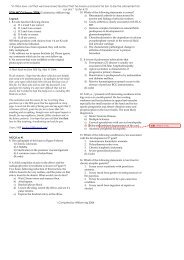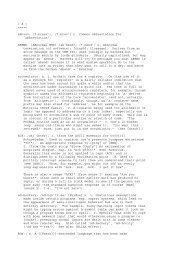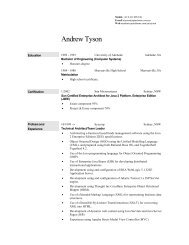Notes to Submission to the Productivity Commission Inquiry into the ...
Notes to Submission to the Productivity Commission Inquiry into the ...
Notes to Submission to the Productivity Commission Inquiry into the ...
You also want an ePaper? Increase the reach of your titles
YUMPU automatically turns print PDFs into web optimized ePapers that Google loves.
Networked Externalities: Interdependence of Products and SystemsWhere <strong>the</strong> demand for separate products depends on <strong>the</strong> quantity produced of <strong>the</strong> o<strong>the</strong>rproduct and <strong>the</strong>re are many producers and consumers of <strong>the</strong> interdependent products,each is likely <strong>to</strong> be under-supplied. The under-supply will occur in a market environmentand it is also likely <strong>to</strong> occur in a social accounting environment if <strong>the</strong> social accounting isdone on a partial basis ra<strong>the</strong>r than a general one.The accessible transport-building network can be taken as illustrative of networkexternalities because accessible buildings make accessible transport more valuable andaccessible transport makes accessible buildings more valuable. Conversely, accessiblebuildings are of minimal value if <strong>the</strong> transport <strong>to</strong> <strong>the</strong> building does not exist or is veryexpensive or unreliable; and accessible transport is of little value if <strong>the</strong>re is nowhere <strong>to</strong> goat <strong>the</strong> end of <strong>the</strong> line because <strong>the</strong> buildings are inaccessible.Transport and buildings are taken as illustrative of network effects, but for people withdisability <strong>the</strong> issues span education, income support, personal care support andemployment opportunities. Thus resources spent breaking down employment barriers arewasted without an accessible education system and without safety net incentives whichencourage ra<strong>the</strong>r than discourage workforce participation; and conversely, an accessibleeducation system is of little use without employment opportunities available at <strong>the</strong> end of<strong>the</strong> education. Similarly, for people with disabilities, <strong>the</strong> incentive <strong>to</strong> participate inemployment depends on a complex inter-relationship of cost, reliability and quantity ofpersonal care service and personal equipment; accessible and reliable building andtransport service; and wages levels and tax rates relative <strong>to</strong> income support payments andtaper rates. Clearly <strong>the</strong>se issues span Federal- State-Local Government jurisdictions and<strong>the</strong>y also span portfolios within jurisdictions (care, equipment, education andemployment, transport at <strong>the</strong> state level; income support and employment at <strong>the</strong> Federallevel; buildings and transport at <strong>the</strong> local level). Each jurisdiction and department isinclined <strong>to</strong> adopt a partial approach ra<strong>the</strong>r than <strong>the</strong> general approach that is appropriatefor a legitimate cost-benefit analysis.Market Environment:In <strong>the</strong> market environment, <strong>the</strong> situation is a classic spillover that might be resolved if<strong>the</strong>re were only a small number of producers and consumers (of buildings and transport)who could negotiate a Coasian resolution. But because <strong>the</strong>re are many independentpeople with disabilities interested in transport and buildings, and many independentproducers of access <strong>to</strong> buildings and transport, negotiations between building andtransport producers and consumers are unlikely given <strong>the</strong> high cost and relativelynegligible private benefit <strong>to</strong> negotiations. Without negotiated compensating paymentshowever, no individual producer will have incentive <strong>to</strong> account for <strong>the</strong> benefit <strong>the</strong>y conferon o<strong>the</strong>rs, and none will <strong>the</strong>refore supply efficiently.Subsidies, government production and mandated regulations have been <strong>the</strong> traditionalmeans of overcoming <strong>the</strong> problem of under-supply due <strong>to</strong> positive externalities.Disability policy has used each of <strong>the</strong>se methods in one area or ano<strong>the</strong>r, and <strong>the</strong> DDA21
















